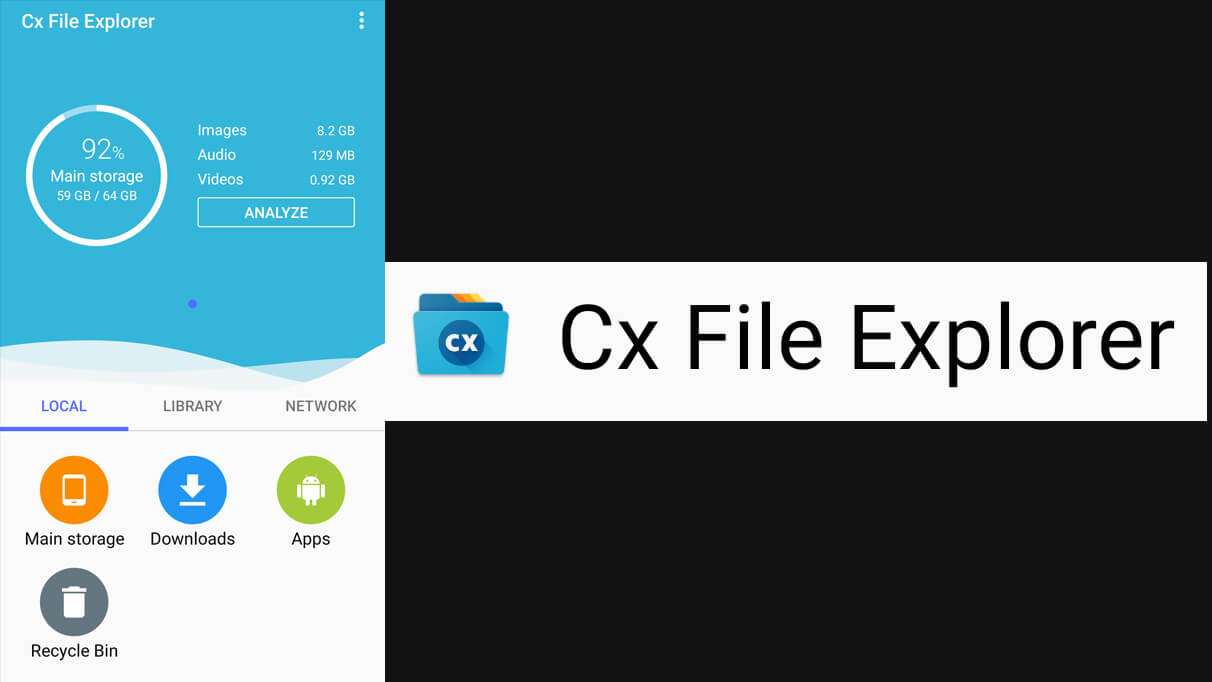“Okay, here is an article about Cx File Explorer, aiming for approximately 1600 words, written in English.
Okay, here is an article about Cx File Explorer, aiming for approximately 1600 words, written in English.

Cx File Explorer APK: Unlocking the Full Potential of Your Android Storage
In the age of smartphones and ever-increasing digital content, managing the files stored on our devices has become more crucial than ever. Photos, videos, documents, downloaded files, applications – they all reside within the confines of our phone’s internal storage or an external SD card. Without an efficient tool to navigate, organize, and manage these digital assets, our devices can quickly become cluttered, slow, and difficult to use.
While Android comes with a built-in file manager, it’s often basic, lacking advanced features that power users or even average users dealing with complex file structures might need. This is where third-party file explorer applications step in, offering a more robust, feature-rich, and user-friendly experience. Among the plethora of options available, Cx File Explorer has steadily gained popularity and a strong reputation as one of the best file managers for Android.
This article delves deep into what makes Cx File Explorer stand out, exploring its features, user interface, performance, and why it’s often the go-to choice for users looking for a powerful yet intuitive way to manage their Android files. We’ll discuss its capabilities, from basic file operations to advanced network and cloud storage integration, and touch upon the "APK" aspect, explaining what it means in the context of Android applications.
What is Cx File Explorer?
At its core, Cx File Explorer is a free, powerful, and easy-to-use file manager application designed specifically for Android devices. Developed by Cx File Explorer, it aims to provide a clean, modern, and efficient way for users to handle all types of files and folders on their smartphones or tablets.
Unlike some older or less reputable file managers that became notorious for being cluttered with ads, bundled software, or excessive permissions, Cx File Explorer has built its reputation on being clean, fast, and focused purely on file management. It offers a comprehensive set of features without unnecessary bloat, making it appealing to a wide range of users, from those who just need to find a downloaded PDF to those who need to connect to network shares or analyze storage usage.
The term "APK" in "Cx File Explorer APK" simply refers to the file format used by the Android operating system for distribution and installation of mobile applications. When you download an app from the Google Play Store, you are essentially downloading and installing an APK file, albeit through a managed and secure process. While APK files can also be obtained from sources outside the Play Store, the official and recommended way to get Cx File Explorer is always through the Google Play Store to ensure you receive a legitimate, safe, and up-to-date version.
Why Choose Cx File Explorer? The Need for a Superior File Manager

You might wonder, "Why do I need a dedicated file explorer when my phone already has one?" The answer lies in the limitations of default file managers and the increasing complexity of managing digital life on a mobile device.
- Limited Functionality: Default file managers often provide only the most basic functions: browse, copy, paste, delete, rename. They might lack features like advanced search, file compression/decompression, detailed storage analysis, or network connectivity.
- Poor User Interface: Some built-in file managers can be clunky, difficult to navigate, or visually unappealing, making simple tasks feel cumbersome.
- Lack of Advanced Features: Accessing files on a computer over a network (SMB), connecting to an FTP server, or seamlessly integrating cloud storage services (like Google Drive, Dropbox, OneDrive) are features rarely found in default managers but are essential for many users.
- Storage Management Issues: As storage fills up, identifying what’s taking up space can be a challenge with basic tools. A good file manager provides visual aids and tools to analyze storage effectively.

Cx File Explorer addresses these shortcomings by offering a feature-rich, intuitive, and high-performance alternative. It transforms the way you interact with your device’s storage, turning a potentially frustrating task into a simple and efficient process.
Key Features of Cx File Explorer
Let’s dive into the specific features that make Cx File Explorer a top contender in the file management space:

-
Clean and Intuitive User Interface (UI):
- One of the first things you notice about Cx File Explorer is its modern, clean, and user-friendly interface. It adheres closely to Material Design principles, making it look and feel familiar to Android users.
- The main screen provides quick access to different storage locations (Internal Storage, SD Card) and categories (Images, Videos, Audio, Documents, Downloads, Apps).
- Navigation is straightforward, typically involving a navigation drawer for main sections and tabbed browsing to easily switch between different folders or locations you’re working with simultaneously. This tabbed interface is a significant productivity booster.
-
Comprehensive File Management Operations:
- All the essential file operations are readily available: Copy, Cut, Paste, Delete, Rename, Move. These are implemented efficiently, even for large files or batches of files.
- Creating new folders and files is simple.
- Selecting multiple files or folders is easy, allowing for batch operations.
-
Storage Analysis:
- This is a standout feature. Cx File Explorer provides a visual breakdown of your storage usage. A clear pie chart shows how much space is occupied by different file categories (images, videos, audio, documents, apps, others).
- More importantly, it offers tools to analyze storage deeply. You can quickly identify large files, recently created files, and even duplicate files that are wasting space.
- This analysis helps users understand what’s consuming their storage and makes it easy to locate and delete unnecessary files, effectively freeing up space.
-
Network Storage Access:
- Cx File Explorer excels in connecting to remote storage locations over a network. It supports various protocols:
- SMB (Samba): Allows you to access shared folders on Windows computers, NAS (Network Attached Storage) devices, and other devices using the SMB/CIFS protocol. This is incredibly useful for transferring files between your phone and PC wirelessly.
- FTP (File Transfer Protocol): Connect to FTP servers to upload or download files.
- SFTP (SSH File Transfer Protocol): A more secure version of FTP that uses SSH encryption.
- WebDAV: Access files on servers that support the WebDAV protocol.
- Setting up these connections is relatively simple, and once configured, the network location appears like any other folder, allowing you to browse, copy, paste, and manage files remotely.
- Cx File Explorer excels in connecting to remote storage locations over a network. It supports various protocols:
-
Cloud Storage Integration:
- Seamlessly connect and manage files stored in popular cloud services directly within the app. Cx File Explorer supports major providers like Google Drive, Dropbox, OneDrive, and Box.
- This feature eliminates the need to switch between different cloud apps just to access a file. You can browse your cloud storage, download files, upload files from your device, and even move/copy files between different cloud services or between cloud and local storage.
-
App Management:
- Cx File Explorer includes a basic but useful app manager. You can view a list of all installed applications, see their size, and easily uninstall them.
- Crucially, it allows you to back up installed applications by extracting their APK files. This is handy for creating backups or sharing apps (ethically and legally, of course).
-
Recycle Bin:
- Accidentally deleted an important file? The Recycle Bin feature provides a safety net. When you delete files using Cx File Explorer, they are moved to a temporary Recycle Bin folder, from where you can restore them if needed. This prevents permanent data loss from accidental deletions. You can also empty the Recycle Bin to permanently remove files and free up space.
-
Compression and Decompression:
- The app supports working with compressed archives. You can create ZIP archives of files and folders.
- It can also extract files from various archive formats, including ZIP and RAR. This is essential for handling downloaded compressed files.
-
Remote File Access (FTP Server):
- Cx File Explorer can act as an FTP server, allowing you to access your phone’s storage from a computer or another device over the same Wi-Fi network using an FTP client. This provides another convenient way to transfer files wirelessly without cables.
-
Internal Storage and SD Card Management:
- It clearly distinguishes between internal storage and any inserted SD card (external storage), allowing you to easily navigate and manage files on both. Transferring files between internal and external storage is a common task made simple.
-
Root Explorer (for Rooted Devices):
- For users with rooted Android devices, Cx File Explorer offers root access capabilities. This allows power users to access and manage system files and folders that are normally restricted, providing full control over the device’s file system (use with caution!).
